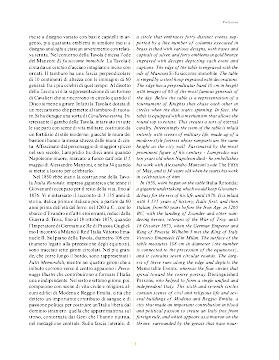incise a disegno variato con basi e capitelli in ar- gento, più quaranta emblemi in similoro incisi a disegno analoghi a ciascun avvenimento con relati- va scritta. Nel contorno della Tavola è incisa l’ode del Manzoni Ei fu siccome immobile. La Tavola è cinta da un cerchio d’acciaio intagliato e inciso con ornati. Il tamburo ha una fascia perpendicolare di 10 centimetri di altezza con le immagini di 60 generali fra i più celebri di quel tempo. Al disotto della Tavola vi è la rappresentazione di un torneo di Cavalieri che si rincorrono in circolo quando il Disco si mette a girare. Infatti la Tavola è dotata di un meccanismo che permette al tamburo di ruota- re. Si ha dunque una sorta di Cavalleria eterna. In- teressante il gambo della Tavola, intarsiato in tutte le sue parti con scene di vita militare, costituito da un fortilizio di stile moderno, giacché le mura dei bastioni hanno la stessa altezza delle mura di cin- ta. Affascinato dal personaggio di maggior spicco nel suo secolo, Lampridio ha dieci anni quando Napoleone muore, marcato a fuoco dall’ode Il 5 maggio di Alessandro Manzoni, e ne ha 34 quando si mette a lavoro per celebrarlo. Nel 1850 ebbe inizio la costruzione della Tavo- la Italia Rotonda: impresa gigantesca che tenne il Giovanardi occupato per il resto della vita, no al 1876. Vi è intarsiato il racconto di 3.135 anni di storia, italica prima e italiana poi, a partire da 60 anni prima dell’età del ferro, nel 1260 a.C., con lo sbarco d’Evandro e d’altri eroi erranti, reduci dalla Guerra di Troia, no al 18 ottobre 1875, quando l’Imperatore di Germania e Re di Prussia Gugliel- mo I incontrò a Milano il Re d’Italia Vittorio Ema- nuele II. Sul piano della Tavola, diametro 108 cm. (numero legato alla precessione degli equinozi), sono tracciati sette gironi circolari. Nel più gran- de, che corre lungo il bordo, sono rappresentati i Fatti Memorabili, mentre nei quattro gironi che a imbuto corrono verso il centro appaiono i Perso- naggi Illustri che contribuirono a formare l’Italia una e indipendente. Nel sesto e settimo girone, poi, compaiono con scene di vita civile e religiosa al- cuni edi ci di Modena e Reggio Emilia, città che dettero un importante contributo di sangue e di passione politica per costruire un’Italia libera dal dominio straniero: quella che appare matrona sul trono, contornata dai Geni che l’hanno nutrita, nel medaglione centrale. Sulla fascia laterale, di a circle that embraces forty distinct events sup- ported by a like number of columns executed in brass etched with various designs, with bases and capitals of silver, and forty emblems in gold bronze engraved with designs depicting each event and captions. The edge of the table is engraved with the ode of Manzoni Ei fu siccome immobile. The table is ringed by a steel hoop engraved with decorations. The edge has a perpendicular band 10 cm in height with images of 60 of the most famous generals of the day. Below the table is a representation of a tournament of Knights that chase each other in circles when the disc starts spinning. In fact, the table is equipped with a mechanism that allows the round top to rotate. This creates a sort of eternal cavalry. Interestingly the stem of the table is inlaid entirely with scenes of military life, made up of a modern-style fortress whose ramparts are the same height as the city wall. Fascinated by the most prominent gure of his century - Lampridio was ten years old when Napoleon died - he embellishes his work with Alessandro Manzoni’s ode The Fifth of May, and is 34 years old when he starts his work in celebration of him. In 1850, work began on the table Italia Rotonda: a gigantic undertaking which would keep Giovanar- di busy for the rest of his life, until 1876. It is inlaid with 3,135 years of history, Italic rst, and then Italian, from 60 years before the Iron Age, in 1260 BC, with the landing of Evander and other wan- dering heroes, veterans of the War of Troy, until 18 October 1875, when the German Emperor and King of Prussia Wilhelm I met the King of Italy Vittorio Emanuele II in Milan. The surface of the table measures 108 cm in diameter (the number is connected to the precession of the equinoxes), and it contains seven circular rounds. The larg- est of these runs along the edge and depicts the Memorable Events, whereas the four circles that spiral toward the centre portray Distinguished Persons, who helped to form a single uni ed and independent Italy. The sixth and seventh circles contain scenes of civil and religious life and sev- eral buildings of Modena and Reggio Emilia, a city that made an important contribution in blood and political passion to create an Italy free from foreign rule, and which appears as a matron on the throne, surrounded by the greats that have nour- Prefazione 13
